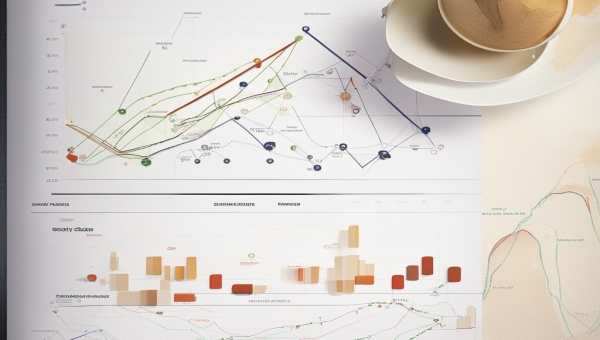Table of Contents:
Introduction: Embracing Chart Analysis Techniques
Trading in the world of cryptocurrencies is not a simple ride. It's filled with complex processes and puzzling charts. But, don't let that hinder your journey to becoming a successful trader. With the right set of skills and tools, you can turn those bewitching graphs into gold mines. Welcome to the universe of Chart Analysis Techniques, a crucial skill set every trader should master.
In this article, we will guide you from the basics to the more advanced chart analysis techniques. It is designed to provide insights for traders of all levels - beginners and experts alike. The goal? To help you make more informed trading decisions, maximize your crypto profits, and most importantly, minimize potential losses. Knowledge is power, and in this case, that power can lead you to financial success.
Chart Analysis Techniques are tools for understanding trading patterns and predicting future price movements. They are the cornerstones for any trader aiming to ride the crypto tide. After reading this article, you will grasp the key analysis techniques essential for a fruitful journey in the world of crypto options trading.
Understanding Basics: Reading Candlestick Charts
Before diving into the more advanced chart analysis techniques, we need to start with the basics. One of the simplest but most effective ways to understand market trends is through Candlestick Charts. Used extensively in financial markets, these charts provide vital information about price movements in a given time.
A candlestick is composed of a body, which represents the range of prices between opening and closing, and wicks or shadows, which represent the high and low prices during the trading period. The different combinations of these elements create a pattern that traders interpret to predict future price movements.
For instance, a long candle body indicates strong buying or selling activity, while a short body suggests the opposite. Similarly, long upper and lower wicks could mean possible reversal of the current trend, indicating a good time for traders to consider entering or exiting a trade.
Mastering candlestick charts opens the door to understanding more complex chart analysis techniques. They serve as the foundation for spotting meaningful patterns and catching potentially profitable trades in the budding world of cryptocurrency.
Pros and Cons of Chart Analysis Techniques for Traders
| Technique | Pros | Cons |
|---|---|---|
| Trend Analysis | Helps identify market direction | May not predict sudden market changes |
| Volume Analysis | Indicates interest in a stock | Could be misleading when not paired with price |
| Moving Averages | Smooths out price history data | Not useful in non-trending markets |
| Pattern Analysis | Predicts potential price breakouts | Patterns may be subjectively interpreted |
Digging Deeper: Recognizing Chart Patterns

Moving beyond candlestick charts, recognising Chart Patterns is the next step in the ladder of chart analysis techniques. It involves identifying specific geometrical shapes formed by price movements over time. Chart patterns can provide potential indications of future price movements and are often seen as a predictor of trend continuation or reversal.
There are various forms of chart patterns including the popular ones like 'Head and Shoulders', 'Double Top', 'Cup and Handle', and 'Rounding Bottom'. Understanding these patterns can benefit traders by providing insights into market sentiment and potential price changes.
For instance, 'Head and Shoulders' pattern, painted by three consecutive peaks where the middle peak is higher than the others, can often signal a bearish reversal. On the other hand, a 'Double Top', characterized by two distinct peaks at a similar price level, can be a clue for future price decline, indicating a good opportunity to sell.
Equipped with an understanding of these patterns, traders can develop effective strategies for both long and short-term trading, making them more adept at tackling the unpredictable nature of the cryptocurrency market.
Techniques for Mastery: Understanding Moving Averages
Kicking your trading proficiency up a notch requires the utilization of more advanced chart analysis techniques. One of the crucial ones to grasp is the concept of Moving Averages, a technique that helps smooth out price action trends by eliminating the random noise from the data.
In simplest terms, a moving average calculates the average price of a cryptocurrency over a specific period. It's mainly of two types: Simple Moving Average (SMA) which calculates a straightforward average of prices and Exponential Moving Average (EMA) which attaches more weight to recent price information.
Moving averages can provide valuable insights into market direction and potential reversal points. For instance, traders often look for crossovers between short-term and long-term moving averages. A crossover occurs when a short-term moving average crosses above or below a long-term moving average. This event could signal a bullish (upward) or bearish (downward) price trend.
For example, the popular "Golden Cross" happens when a short-term moving average, like the 50-day SMA, crosses above a long-term moving average, like the 200-day SMA, indicating the potential start of a bull market.
On the contrary, the "Death Cross" occurs when the 50-day SMA crosses below the 200-day SMA, which may suggest a bear market on the horizon.
Understanding the implications of moving averages and using them wisely can, therefore, significantly improve your trading outcomes in the volatile cryptocurrency markets.
Conclusion: Chart Analysis Techniques are Essential for Successful Trading

The journey from basics to mastery in chart analysis techniques might seem daunting. But with patience, perseverance, and consistent learning, it is attainable. Figuring out how to read candlestick charts, recognizing chart patterns, and understanding moving averages can vastly improve your trading decisions. These tools will provide you the confidence and insights needed to navigate the complex and exhilarating world of crypto options trading. Remember, every expert was once a beginner. Happy trading!Utilizing Indicators: MACD, RSI and Bollinger Bands
Climbing up the ladder of chart analysis techniques, we reach the concept of trading indicators. Indicators are statistical tools that cryptocurrency traders use to assess price patterns and make informed predictions about future market swings. Let's dive into some of the most effective indicators: MACD, RSI and Bollinger Bands.
MACD (Moving Average Convergence Divergence) is a trend-following momentum indicator. It illustrates the relationship between two moving averages of a cryptocurrency's price. The MACD triggers technical signals when it crosses above (to buy) or below (to sell) its signal line.
MACD assists traders in identifying potential buy and sell opportunities around support and resistance levels, making it a valuable tool in your technical analysis utilities.
Next up, RSI (Relative Strength Index) helps traders gauge the speed and change of price movements. This momentum oscillator fluctuates between zero and 100, and is typically used to identify overbought or oversold conditions in a market. When the RSI reaches a high level—usually around 70—it indicates the market is overbought, and it’s potentially a good moment to sell. Conversely, an RSI level around 30 suggests oversold conditions, pointing towards a buying opportunity.
Lastly, the Bollinger Bands are a volatility indicator and commonly used in crypto trading. The bands expand and contract based on market volatility. The upper band shows a level that's statistically high, and the lower band shows a level that's statistically low. If the price deflates too far and touches the lower band, you may deem the cryptocurrency undervalued and consider buying. If the price pumps and touches the upper band, it could be overvalued, and it's possibly an opportune time to sell.
Understanding these indicators and implementing them in your chart analysis techniques can enhance your market analysis strategy significantly. But remember, no indicator is foolproof. It is therefore crucial always to use them in conjunction with other techniques and adopt a risk management strategy.
Putting It All Together: Combining Techniques for Successful Trading
Armed with an understanding of the basic and advanced chart analysis techniques mentioned above, the next step is to learn how to effectively combine these techniques for successful trading. No single method in isolation will provide a foolproof way to predict price movements. The key to maximizing success lies in the synergy of these techniques.
Simply put, successful traders don’t rely on one or two strategies, instead, they create a toolbox of methods, each making a unique contribution to the overall decision-making process. Incorporating a comprehensive mix of techniques from simple candlestick charts, chart patterns to moving averages, helps paint a fuller picture of market trends.
For example, you could use moving averages as the core of your strategy, relying on crossovers to indicate potential buying or selling opportunities. However, you could further refine this approach by using candlestick charts and chart patterns. They could help confirm these signals and indicate the strength of the trend. A change in candlestick patterns might hint at the weakening of a trend, encouraging you to think twice about entering a trade at that moment.
This combined approach reduces the risk of false signals and helps provide a more accurate understanding of market sentiment and price movements. It's a more holistic strategy that allows for more comprehensive, thoughtful, and ultimately, more profitable trading decisions.
Conclusion: Mastery in Chart Analysis Techniques: An Essential Trading Skill

In conclusion, mastering Chart Analysis Techniques is a critical skill for anyone embarking on the journey of cryptocurrency trading. It's not an overnight task but a continuous learning curve that requires patience, practice, and persistent effort. However, with these tools in your trading arsenal, you'll be well-equipped to navigate the volatile waves of the cryptocurrency market and potentially reap substantial financial rewards.
It's evident that no single technique can predict market movements with absolute certainty, but by combining various methods you can improve your trading decisions. Remember, successful trading means being adaptable, constantly learning, and staying ahead of the curve. Equip yourself with these chart analysis techniques, and you'll ready to conquer the crypto trading world.Conclusion: Undeniable Importance of Chart Analysis Techniques
Unraveling the art of chart analysis can be a game-changer in your trading journey. Whether you are interpreting candlestick patterns, recognizing chart formations, or computing moving averages, these techniques serve as your compass in navigating the fluctuating currency horizons of the crypto world.
Drawing on these essential techniques empowers you to craft robust trading strategies designed to seize potential opportunities and manage risks. It allows you to read beyond the raw numbers and understand the story they are telling. By honing these valuable techniques, you unlock unprecedented possibilities for your financial growth and prosperity in the crypto trading arena.
As the financial landscape continues to morph, staying ahead requires continuous learning and application of such indispensable tools. The importance of chart analysis techniques is undeniable - a crucial component in thriving in the cryptic world of cryptocurrencies. Buckle up and equip yourself. The future of trading awaits.
FAQ for 'Chart Analysis Techniques for Trading Mastery'
What are the basics of chart analysis in trading?
Trading chart analysis starts with understanding the types of charts, bars, candlesticks, and indicators. Traders look for trends, support / resistance levels, and patterns to make decisions.
How can one master chart analysis?
Mastering chart analysis requires substantial practice, understanding of the market, and continuous learning. Using various types of analysis, such as technical and fundamental, and staying updated with market news is also beneficial.
What chart analysis techniques are important for traders to know?
Important techniques include understanding of trends, drawing trend lines, identifying support and resistance levels, recognition of chart patterns, and utilization of technical indicators.
How is chart analysis beneficial in trading?
Chart analysis provides insights into historical performance and future probabilities. It helps in decision making, risk management, and determining when to enter or exit a trade.
Can chart analysis predict future price movements?
While chart analysis cannot predict future prices with absolute certainty, it can suggest likely scenarios based on historical data. It provides a logical approach to understanding past performance and forecasting potential future moves.




